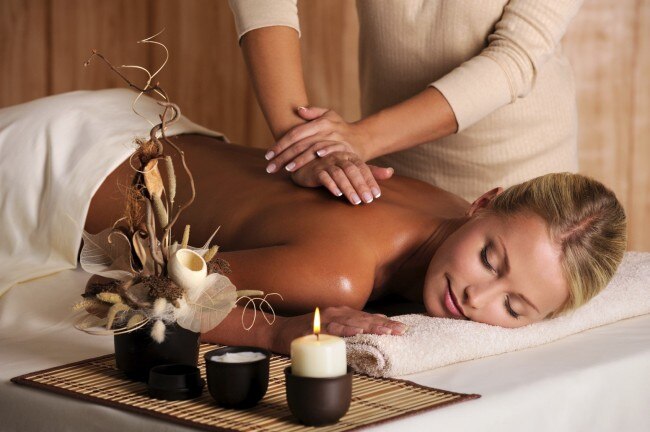Your muscles ache, you feel drained and your body is stiff in new and interesting ways. You debate treating yourself to a massage, but you have no idea what kind, or where to find a practitioner. You take a hot bath and think that will solve what ails you, but tomorrow brings more of the same. 
Massage can be a surprisingly effective solution—if you know what to look for. “There are enormous benefits to massage,” says Stephen West, who taught at the Boulder College of Massage Therapy for several years and has a private bodywork practice in Boulder, Colorado. “Across the country, hands-on, soft tissue–based work is being recognized as having true clinical therapeutic applications, from calming the nervous system to treating injury,” West says.
Numerous studies suggest that massage reduces pain and muscle spasms in hospital patients who have multiple incisions, and bodywork is widely recognized as helpful for conditions such as back and neck pain, as well as osteoarthritis.
Nationwide, an increasing number of hospitals and clinics have started offering massage services for both inpatient and outpatient care. A 2010 survey conducted by the American Hospital Association’s Health Forum and Samueli Institute, a nonprofit research organization, found that 40 percent of hospitals indicated they offer one or more alternative therapies—up a whopping 37 percent from a 2007 survey. Additionally, more medical offices and clinics are employing bodywork practitioners.
Whatever your circumstances, massage can be a boon. Everyone, over time, develops asymmetrical patterns of tension and restriction in their body that can throw them out of whack, says West. But the term massage can be confusing, referring to everything from spa-style pampering and decompression to physical rehabilitation. Many serious practitioners prefer the term bodywork, which denotes a more intentional, therapeutic experience that aims to address—and help correct—deeply ingrained patterns in the body
When considering a therapy, ask yourself what you are looking for. Is it relaxation? Treatment for an injury? Help to address chronic issues? If a soothing, feel-good experience is what you’re after, certain modalities, such as Swedish massage, may be a fit. On the other hand, if you are looking for therapeutic relief, modalities such as neuromuscular technique could provide more long-lasting benefit.
While there are many massage techniques, below you will find our roundup of four of the most popular.
Swedish Massage
One of the oldest and most popular massage styles, Swedish massage has many different applications, from relaxation to releasing knotted muscles. Pioneered by a Swedish physiologist in the early 19th century, this massage technique is also the foundation of both deep-tissue and sports massage. During a session, the practitioner will lubricate the skin with oil and employ long, sweeping strokes along the body. Typically, the practitioner will work on the body in a rhythmic, symmetrical fashion, following a distinctive pattern of strokes. The four basic strokes used in Swedish massage are effleurage (smooth, gliding strokes); petrissage (squeezing and kneading); friction (rubbing the soft tissues against each other); and tapotement (a short, tapping movement done with the fingers).
Deep tissue
Focusing on the deeper layer of muscles and connective tissue, this style of bodywork is helpful for chronic problem spots. Strokes use deep pressure and friction with the goal of breaking down adhesions—fibrous bands of scar tissue or patterned restriction—in the fascia, the structure of connective tissue that surrounds muscles. Deep-tissue work can alleviate symptoms of chronic pain, increase functional range of motion and improve posture. Little lubrication is used, and knuckles, fists, forearms and elbows create more localized, effective (read: intense) pressure.
Shiatsu
A traditional hands-on Japanese healing art, shiatsu focuses on the meridians, or energy pathways that circulate through the body. Shiatsu’s goal is to restore the body’s natural energy flow by massaging the surface of the skin. This form of bodywork stimulates the meridians—each of which is associated with a vital organ—and many of the more than 600 acupoints, or tiny energy channels present in the body. Shiatsu can reduce stress, relieve muscular tension, boost the immune system, improve circulation and enhance well-being and vitality. You’ll stay clothed for this massage, and the practitioner will apply pressure through thumbs, fingertips, palms, knuckles, elbows, knees and sometimes feet. Besides pressure, Shiatsu protocol involves squeezing and rocking movements, stretching exercises and gentle holding techniques.
Neuromuscular Technique (NMT)
While deep tissue tends to focus on the muscles and tendons, NMT is an in-depth exploration of the body’s connective tissue. Defined as the utilization of static pressure on specific myofascial points to relieve pain and balance the central nervous system, NMT identifies five elements that cause pain: ischemia (lack of blood supply); trigger points (irritated areas of the muscle that refer pain to other parts of the body, sometimes far from the actual site of the pain; nerve compression; postural distortion; and biomechanical dysfunction, in which physical imbalances translate into unhealthy movement patterns. Practitioners use strategies such as cross-fiber friction, pin and stretch, and active release techniques to alleviate chronic pain and help heal injuries.
Many techniques, such as NMT, myofascial techniques like Rolfing, and somatic patterning work such as Aston Patterning, aim to treat the cause of pain, not merely the symptoms. Ultimately, a more experienced therapist will bring his own unique blend of approaches to his work. “I’m especially interested in empowering the client and engaging them on a proactive level so that they can integrate the change they experience in a session into all that they do—this involves movement and postural education, strengthening, stretching, breath work, even looking at our habitual ways of doing things,” says West.
Of course, the quality of your bodywork session will be determined not just by what method you choose, but by the skill of your practitioner. To find a reputable practitioner, West recommends searching through sites such as American Massage Therapy Association or Associated Bodywork or , two national organizations that vet their members through approved massage programs and eligibility requirements.
